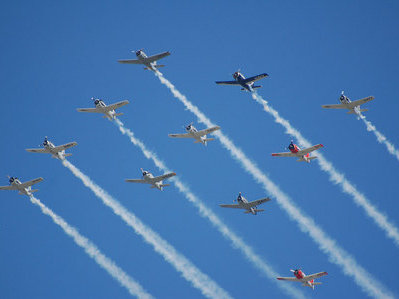The cars filing into Wittman Regional Airport last Monday for the start of the Experimental Aircraft Association's annual AirVenture sported license plates from at least half of the fifty states and waited bumper-to-bumper for a parking spot.
They were driven by the campers and the visitors, those not lucky enough to have flown in on their own planes, but enthusiastic enough about aviation to spend some of their day at the event.
The pilots who landed at Wittman represented an even more diverse crowd than the geographic grab-bag of visitors. They landed in restored warbirds, antiques and classics, home-builts made from scratch and from kits.
Though diverse, they mark a unique and separate aviation culture from the corporate exhibitors in the middle of the grounds, which show off gleaming private jets and pre-built planes.
For those who restored classic planes or built from kits, it's impossible to separate the pilot from the engineer who ratcheted the machine together. Most love their planes like an extension of their own families, and like proud parents showing off pictures of newborns, talk about their history with the plane. But that's it.
Most were uncomfortable talking "on the record." They dodged questions about their professions and lives before they found flying. For these folks, the week is about sharing their passion with other pilots and "homebuilders," and that's it.
Their brotherhood is a marked contrast from the corporate displays available to visitors at the main gate. Embraer, Boeing, Cirrus, Cessna are just a few of the big names with a handful of planes for a variety of both personal and corporate uses.
Those in the market for one of these planes largely appreciate the utilitarian aspect of the planes, of getting from A to B, a contrast with the recreational pilots.
Other smaller corporate exhibits appeal to the adventurers. One in particular, Icon Aviation, caters to the sporty crowd looking for a little bit of fun beyond taking jet skis out on a sunny Saturday. Their A5, slated to be shipped next winter, is a Light Sport Aircraft, a designation created by the Federal Aviation Administration in 2005.
Flying one of these machines requires less training and preparation than a traditional pilot's license. The planes, which look like expensive toys out of a James Bond movie, are treated like a boat: they can fit in a garage, were designed to be carried on a trailer, but can also take flight from the water.
Starting at $130,000, they cost more than most ski boats on the market, but offer a new flavor of adventure. In demonstration, the reps noted that it can be flown with the windows down, and is ideal to be flown on a clear summer day over short distances, much like taking out the convertible for a lazy afternoon drive. It's surely exciting, but it's not some of the other pilots' cup of tea.
Owners of the homebuilts and vintage planes shook their heads when asked if they'd like one of those planes.
"I like to be able to fly something I've built with my own hands," said one pilot of a kit plane.
"That thing is too corporate," he added, referring to the A5.
The pilots who would willingly discuss their lives outside of aviation weren't jillionaire businessmen. They're engineers, mechanics and teachers, enjoying a unique hobby. It's surely an expensive avocation, but in most cases, all of their spare resources go into flying -- from purchasing new kits or planes to paying for maintenance, repairs and fuel.
Of course, the wealthy have their place, too. NASCAR mogul Jack Roush -- who owns hometown favorite Matt Kenseth's team -- is a celebrity among the history buffs who come to check out his P-51 Mustang and learn about its history. Ford Motor Company even sponsored an autograph session with Roush.
Certainly anyone with an appreciation for aviation and its history recognizes Roush's efforts to maintain it, but some do more than others. Around the warbird community -- those who bring in restored fighter planes from as early as World War I that have flown for both America and other countries -- preserving and sharing history is the hallmark of their week at EAA.
Owners of vintage restorations -- old planes not used in combat -- generally agree that their passion derives primarily from being a part of aviation history. This camp, much like the homebuilders, stands distinct and separate from the corporate crowd.
These differences of course are gentlemanly and civil, like a tame rivalry between two friends who argue over whether Coke or Pepsi is the superior drink.
Smart pilots or aviation enthusiasts will recognize the necessary function of each camp of pilots, how both corporate jets and vintage restorations contribute to aviation culture and history, and how they each contribute to it themselves.
In a year many of the same will gather again, rekindling the relationships and bonds at this annual spectacle, united in their love of the freedom to fly.



